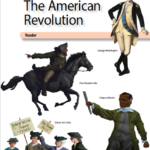This short video traces the crises of the 1760s (e.g., the Stamp Act, the Townshend Act) through to the relatively quiet early 1770s, culminating in the Boston Tea Party of 1773. Professor Jack Rakove emphasizes the role of individual in history. Governor Thomas Hutchinson forced a crisis—the Boston Tea Party–by insisting on strict enforcement of the Tea Act. He could have chosen a different tactic (as did other governors), but chose not to.
The American Revolution (CKHG Unit)

This unit begins by providing background information on the establishment of the thirteen colonies. Across 25 lessons, students learn about early alliances, the French and Indian War, and causes and provocations of the American Revolution. Students are introduced to major ideas in the Declaration of Independence and to key figures in the Revolution, as well as art and literature representative of the period.
Includes 25 lessons of roughly 45 minutes each.
Women During the American Revolution

This short video illustrates the degree to which women actively participated in the American Revolution. In response to the Stamp Act, American colonists agreed to stop importing British goods and the colonial women led the boycotts of tea, fine cloth, and other consumer goods. Women began to think of themselves as “Daughters of Liberty.” Professor Rosemarie Zagarri explains how male political leaders came to acknowledge the political capacity and potential of women during this era.
